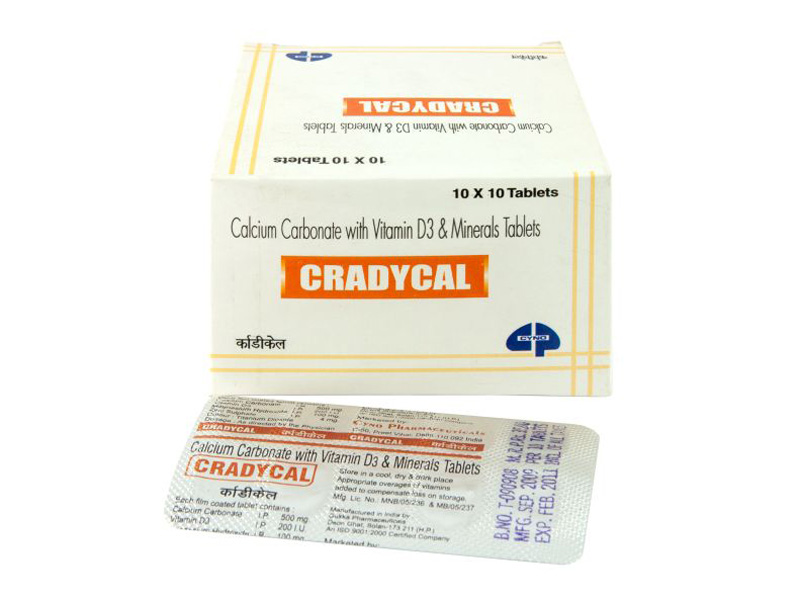CRADYCAL
Calcium Carbonate (500 mg), Vitamin D3 (200 I.U.), Magnesium Hydroxide (100 mg), Zinc Sulphate (4 mg)
Vitamins are vital for the normal metabolism of the body. Vitamins vary in their chemical structure and are supplied in small amounts in the diet because they are not synthesized in the body or their rate of production is not sufficient for the maintenance of health (eg. niacin synthesis from tryptophan.) Vitamin deficiency in the body may lead to the development of deficiency symptoms. Different vitamin preparations are available for prophylaxis and treatment, Most vitamins are non-toxic but prolonged intake of Vit. A and Vit. D can cause toxicity.

Mechanism of Action:
All genomic actions of 1,25 (OH) 2D are mediated by VDR. VDR is a transcription factor and a member of the steroid hormone nuclear receptor family. It consists of three domains: the N-terminal DNA binding domain consisting of two zinc fingers that bind the discrete sites (VDREs), the C-terminal ligand-binding domain, and the hinge region together with two domains. The ligand-binding domain structure has been solved by X-ray crystallography (Rochelle et al., 2000). It consists of 12 helices. The terminal helix acts as a gating mechanism around the ligand involved and forms an interface for coactivators as well as facilitating the interaction of the VDR with its heterodimer partner, typically the RXR. Although there is substantial variability in the sequence of VDREs, the majority of those with the highest affinity for VDRs are direct repeats of hexanucleotides with a difference of 3 nt between half-sites, a motif known as as DR3. VDR binding to its VDRE then recruits coregulatory complexes required for its genomic activity. These complexes can be both gene and cell-specific, enabling selectivity of 1,25 (OH) 2D action from cell type to cell type.
Pharmacokinetic Properties:
Absorption and distribution of essential trace element zinc in humans were investigated by a pharmacokinetic study of the serum zinc profile in 10 subjects after oral administration of a pharmacological dose of the metal, that is, 0.69 mmol (45 mg) of zinc as ZXSO4.7 H 2 O. The experimental conditions adopted include frequent measurement of serum concentrations, total probe time of 8 hours after ingestion, and improvement in basal zinc levels taking into account circadian variation.
This study was performed to compare the pharmacokinetic indices of calcium absorption after a single oral (500 mg calcium) load of Citracal (calcium citrate) and Os-Cal (calcium carbonate). In 18 postmenopausal normal women, venous blood samples were obtained before and after a meal of Citracal, Os-Cal or placebo breakfast for 6 hours for the measurement of calcium per hour.
Drug- Drug intreactions:
Calcium can make it harder for your body to absorb certain medications. If you take other medicines, take them at least 2 hours before or 4 or 6 hours after taking calcium carbonate.
Other drugs may interact with calcium carbonate, including prescription and over-the-counter medicines, vitamins, and herbal products. Tell your doctor about all your current medications and any medications that you start or stop using.
Drug interactions can change how your medications work or increase your risk for serious side effects. This document does not contain all possible drug interactions. Keep a list of all the products you use (including prescription / nonprescription drugs and herbal products) and share them with your doctor and pharmacist. Do not start, stop, or change the dose of any medicine without your doctor’s approval.
Warnings and Precautions:
- Hypersensitivity.
- High calcium levels in urine.
- Kidney stones.
- Low phosphate levels.
- High calcium levels.
- Suspected dioxin poisoning.
Breast feeding:
Calcium is found in breast milk. When calcium carbonate is used at recommended doses, it is unlikely to be harmful to the nursing child.
Fertility:
When men take calcium carbonate, there have been no studies looking at male fertility in pregnancy or potential problems for pregnancy.
Dosage:
Take the missed dose as soon as you remember. If it is almost time for your next scheduled dose, skip the missed dose. Do not take extra medicine to make up for the missed dose.
Duration of action:
Up to 2 week
Adverse reaction:
Get emergency medical attention if you have signs of an allergic reaction: urticaria; Shortness of breath; Swelling of your face, lips, tongue or throat.
Storage:
Conditions for safe storage: Store in a cool, dry area. Store materials are tightly sealed in properly labeled containers. Protect from moisture.
Over dosage:
Take the missed dose as soon as you remember. If it is almost time for your next scheduled dose, skip the missed dose. Do not take extra medicine to make up for the missed dose.
Contraindications:
Calcium carbonate is used in cases of hypersensitivity, kidney stones, high urinary calcium levels, elevated serum calcium, low serum phosphate, achlorhydria or suspected detoxin poisoning.
Side effects:
- Get emergency medical attention if you have signs of an allergic reaction: urticaria; Shortness of breath; swelling of your face, lips, tongue, or throat.
- Call your doctor once if you have:
Little or no urination; Swelling, rapid weight gain; or High levels of calcium in your blood – nausea, vomiting, constipation, increased thirst or urination, muscle weakness, bone pain, confusion, lack of energy, or feeling tired. - Common side effects may include:
Stomach upset, gas; or Constipation.
Warnings:
Follow all instructions on your medication label and package. Tell each of your healthcare providers about all of your medical conditions, allergies and all the medicines you use.
Pregnancy:
Normal daily intake of calcium carbonate appears to be safe and effective to use during pregnancy. During pregnancy, the use of calcium carbonate above the recommended dietary allowances should be avoided.
